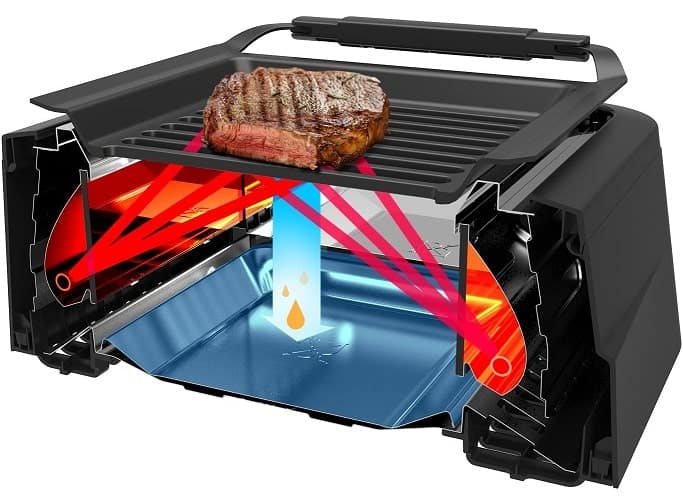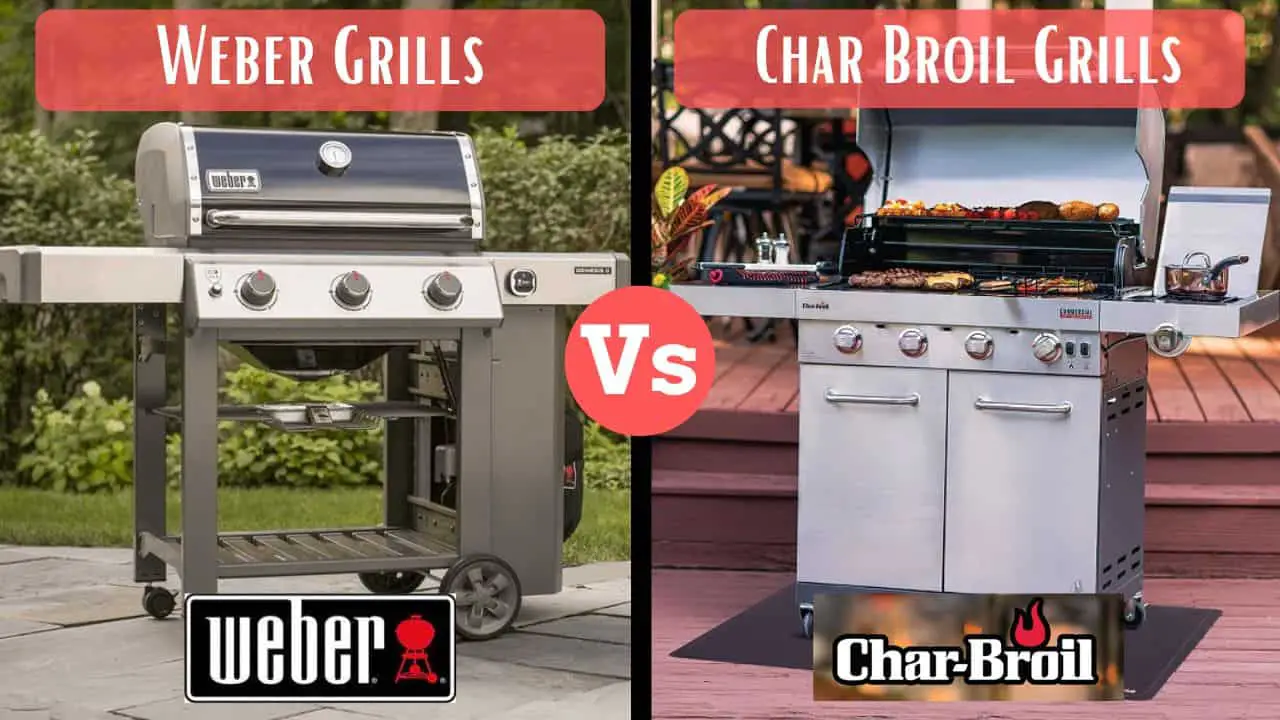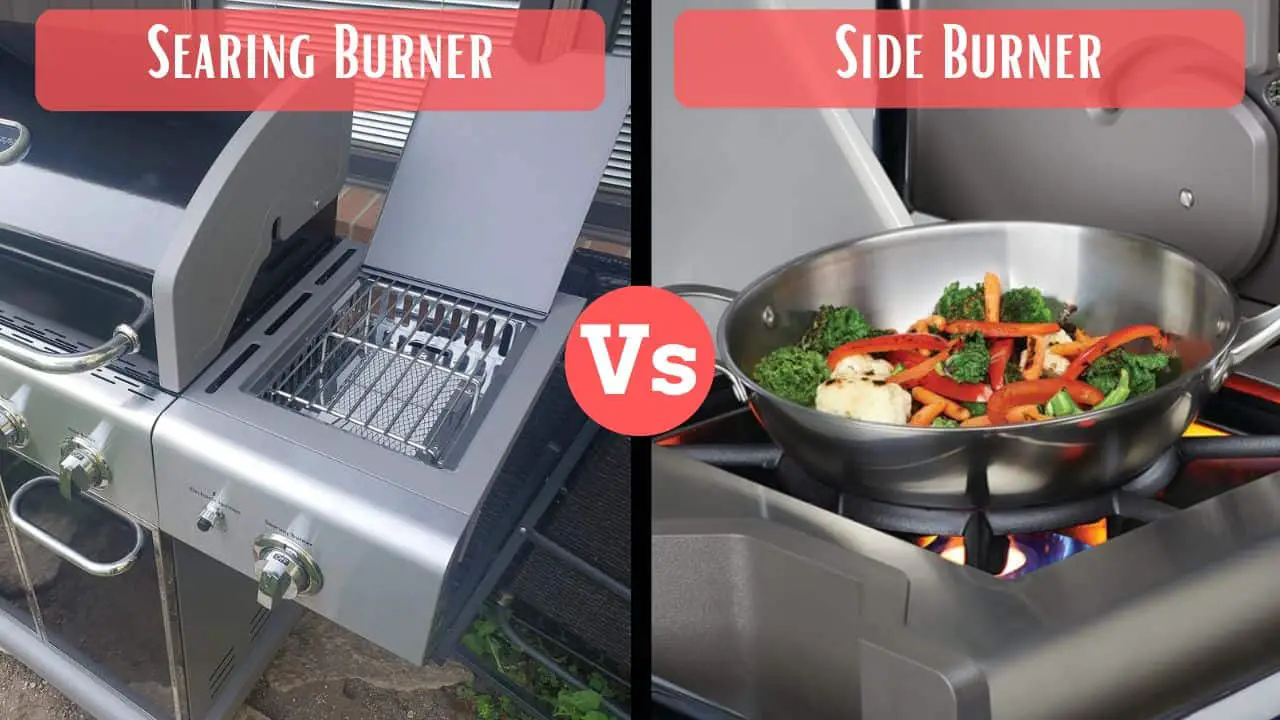I’ve heard about infrared radiation, and the use of this technology in thermal imaging cameras, fiber optic cables, and remote controls.
But what about grills? The new infrared grills have become extremely popular among grilling enthusiasts and commercial steakhouses alike and even I have one myself.
Well, I jumped on the bandwagon, and here’s the lowdown on how infrared grills work, the food they can cook, and why they’re worth the money.

Table of Contents
How Does an Infrared Grill Work?
As the name suggests, infrared grills are backed by infrared technology, and here’s how they work to heat up and cook your food.
In order to understand how an infrared grill works, you need to know that there are basically three ways to cook food—convection, conduction, and radiation.
Conduction is the direct transfer of heat from one object to another such as when your frying eggs or sausage on a frying pan. The burner of the stove heats the frying pan, which then cooks the food in it.
Convection uses a flow of hot water or air to cook food such as when you’re roasting a turkey in your oven or boiling pasta in water.
Older gas grills use convection to create a flow of hot air around the food, and there are a few traditional grills that use some conduction to transfer heat to the food on the grill via the hot grill grates.
Infrared grills use the radiation cooking method in the form of electromagnetic energy to transfer heat directly to the food.
Most infrared grills are fitted with an infrared burner that’s located between the conventional gas burners and the cooking surface.
The gas burners heat the infrared burner, which then directs intense heat directly to the food items on the grill surface.
Radiant heat is also used when you switch on the broiler element in your microwave or conventional oven to make baked items.
A small amount of infrared radiation is also produced by charcoal grills when the coal gets really hot.

Infrared energy is generated by heating up a ceramic or metal surface. Infrared grills work similarly to many regular gas-powered grills, except that they are equipped with a special type of grate
When infrared heat is generated, the lower surface of these grates reaches a temperature of roughly 800 degrees, and their top serrated surface receives roughly 500 degrees.
The heat the reaches the bottom surface of the grates is direct high-velocity energy that is stored in the metal itself.
The heat that reaches the top of the grates is mostly infrared and is an extremely intense kind of energy.
What is Infrared Heating and What is the Science Behind it?
Radiant energy is available in several different forms including the visible waves our eyes can detect, and radio waves.
In terms of the light spectrum, infrared sits just below the lowest frequency red that is visible to the human eyes.
Think of it as a sound that’s too low for the human ears, but is clearly audible to most animals.
Infrared cooking is similar to a sunburn, where the heat is felt only on the surface of the food. The heat reaches the center of the food when the molecules receiving the infrared radiation vibrate at high speeds, resulting in friction and high temperatures.
There are several sources of infrared energy available to cooks, where the oldest is a simple bed of coals from charcoal to hardwood, both of which generate infrared energy at high volumes along with conventional convection heat generated from combustion.
Why is Infrared Grilling Safe?
Cooking food on an infrared grill is similar to cooking in a microwave by using electromagnetic energy.
There is a risk of cancer and other diseases when extremely high energy forms of EM radiation are involved, but infrared grills do not have that amount of high power to alter or denature the protein or any other content in the foods.
However, infrared grills or any other type of cooking appliance could cause certain health conditions if the food isn’t cooked properly at high temperatures.
Food that is cooked at more than 300°F increases the HCAs (heterocyclic amines) and PAHs (polycyclic aromatic hydrocarbons), and causes cancer.
So, even though your food will cook well and quickly on an infrared grill, you need to take the necessary precautions to avoid overcooking your food.
You should also keep kids and pets away from the infrared grill during use, and refrain from fixing any grill parts even if the unit is unplugged, as they can still cause electric shock.
What Makes Infrared Grill Stand Out?
It’s a nice summer Sunday, and you’re hosting a family barbeque! You’ve got all the good stuff—steaks, burgers, chops all prepped and ready to toss on the grill.
You’re well aware of all the cold and hot spots of your grill, so you fire up the grill, toss the food on it, and close it.
You go in to grab some buns, and when you return, the nightmare comes true—a single flare-up has caused your steaks to char, leaving you with no other option but to abandon your cookout.
This aforementioned scenario can be avoided with TRU infrared cooking technology—a mode of grilling that eliminates hot and cold spots prevents flare-ups and provides tender and juicy results.
1. Even-Heat Equals to Better Meat
The ability to produce even heat is one of the key features that sets infrared grills apart from their gas counterparts.
In the convective gas grill, the heat is transferred through the air and to the food via the space between the grates.
This consequently effectively heats the air around the food rather than the food itself. But with infrared grills, even heat heats your food directly, and not the air, allowing the food to retain its juices, and prevents it from drying out.
Furthermore, infrared grills offer consistent and direct heat, thanks to their onsite patented emitter plate that’s located above the heat source, and just under your food.
2. Hotter, Faster, and More Efficient
Even though the heat moves slower in an infrared grill, the time it takes the cook the food is the same as traditional gas grills.
But because there is no heat wasted between the source and the cooking grate, your food cooks faster, and at higher temperatures. These high temperatures are one of the reasons why high-end steakhouses opt for infrared grills.
3. No Flare-Ups
The emitter plate of infrared grills reduces the airflow between the heating element and your food to prevent flare-ups.
When juices drip on the grate, they are vaporized rather than mixing with oxygen and creating a flame. This allows you to enjoy your party without having to check on your food every two seconds.
4. Easy to Clean
Infrared grills are fairly easy to clean, because of their high temperatures. You simply have to heat up the grill to the highest temperature possible to burn any debris, wait for the grill to cool, and gently brush to remove the leftover particles.
Deep cleaning should be performed every six months or so to extend the service life of your infrared grill.
5. Energy Efficient
Grills with has burners consume more fuel, while infrared grills are fuel-efficient while heating. Plus, infrared grills burn less gas to reach the same temperatures as gas grills.
What Temperatures Can Infrared Grills Achieve?
The burners of infrared grills can be of different shapes, where each is fitted with approximately 300 gas jets.
These jets allow infrared grills to achieve temperatures between 800° and 1800°, so you can sear food and cooks three times faster than charcoal temperatures.
What Can you Cook on Infrared Grills?
Most infrared grills offer only two cooking settings—high and off, so you need to cook the right foods due to the intense heat.
Delicate meats, fish, and vegetables aren’t good food options to cook on an infrared grill, as they can incinerate easily.
However, if you have an infrared grill that allows you to adjust the temperature such as the Char-Broil 463655621 Performance TRU-Infrared grill, you can cook delicate items including vegetables for a lightly smoked flavor.
The Char-Broil 463655621 Performance TRU-Infrared grill offers a large 310 square inches of cooking space and is equipped with durable, rust-resistant, and easy-to-clean steel grates.
Adding to this, the Char-Broil infrared grill features an extra warming rack that measures 95 inches and an electronic ignition system for quick startup.
It is equipped with stainless steel burners that emit heat from the top for even heating and arrives in an appealing metal gray finish for enhanced style and durability.
The Char-Broil infrared grill comes with a lid-mounted temperature gauge, so you don’t have to guess the temperature inside the grill. It is easy to assemble and is fitted with four heavy-duty wheels to move it around easily.
To top things off, the Char-Broil infrared grill features folding side shelves, a removable grease pan, and is backed by a manufacturer warranty.




